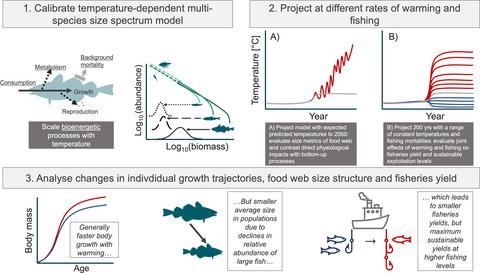当前位置:
X-MOL 学术
›
Glob. Change Biol.
›
论文详情
Our official English website, www.x-mol.net, welcomes your
feedback! (Note: you will need to create a separate account there.)
Temperature impacts on fish physiology and resource abundance lead to faster growth but smaller fish sizes and yields under warming
Global Change Biology ( IF 10.8 ) Pub Date : 2022-07-13 , DOI: 10.1111/gcb.16341 Max Lindmark 1 , Asta Audzijonyte 2, 3 , Julia L Blanchard 3 , Anna Gårdmark 4
Global Change Biology ( IF 10.8 ) Pub Date : 2022-07-13 , DOI: 10.1111/gcb.16341 Max Lindmark 1 , Asta Audzijonyte 2, 3 , Julia L Blanchard 3 , Anna Gårdmark 4
Affiliation

|
Resolving the combined effect of climate warming and exploitation in a food web context is key for predicting future biomass production, size-structure and potential yields of marine fishes. Previous studies based on mechanistic size-based food web models have found that bottom-up processes are important drivers of size-structure and fisheries yield in changing climates. However, we know less about the joint effects of ‘bottom-up’ and physiological effects of temperature; how do temperature effects propagate from individual-level physiology through food webs and alter the size-structure of exploited species in a community? Here, we assess how a species-resolved size-based food web is affected by warming through both these pathways and by exploitation. We parameterize a dynamic size spectrum food web model inspired by the offshore Baltic Sea food web, and investigate how individual growth rates, size-structure, and relative abundances of species and yields are affected by warming. The magnitude of warming is based on projections by the regional coupled model system RCA4-NEMO and the RCP 8.5 emission scenario, and we evaluate different scenarios of temperature dependence on fish physiology and resource productivity. When accounting for temperature-effects on physiology in addition to on basal productivity, projected size-at-age in 2050 increases on average for all fish species, mainly for young fish, compared to scenarios without warming. In contrast, size-at-age decreases when temperature affects resource dynamics only, and the decline is largest for young fish. Faster growth rates due to warming, however, do not always translate to larger yields, as lower resource carrying capacities with increasing temperature tend to result in decline in the abundance of larger fish and hence spawning stock biomass. These results suggest that to understand how global warming affects the size structure of fish communities, both direct metabolic effects and indirect effects of temperature via basal resources must be accounted for.
中文翻译:

温度对鱼类生理和资源丰度的影响导致生长速度加快,但在变暖条件下鱼类体型和产量变小
在食物网背景下解决气候变暖和开发的综合影响是预测海洋鱼类未来生物量生产、大小结构和潜在产量的关键。先前基于基于尺寸的机械食物网模型的研究发现,自下而上的过程是气候变化中尺寸结构和渔业产量的重要驱动因素。然而,我们对“自下而上”的联合效应和温度的生理效应知之甚少;温度效应如何从个体层面的生理学通过食物网传播并改变社区中被剥削物种的大小结构?在这里,我们评估了基于物种分辨的基于大小的食物网如何通过这些途径和开发受到变暖的影响。我们将受波罗的海近海食物网启发的动态大小谱食物网模型参数化,并研究个体生长速度、大小结构以及物种和产量的相对丰度如何受到变暖的影响。变暖的幅度基于区域耦合模型系统 RCA4-NEMO 和 RCP 8.5 排放情景的预测,我们评估了温度对鱼类生理和资源生产力的不同情景依赖性。除了基础生产力之外,在考虑温度对生理的影响时,与没有变暖的情况相比,2050 年所有鱼类的预计年龄平均增加,主要是幼鱼。相比之下,当温度仅影响资源动态时,同龄体型会下降,幼鱼的下降幅度最大。然而,由于变暖导致的更快的生长速度并不总是转化为更高的产量,因为随着温度升高而降低的资源承载能力往往会导致较大鱼类的丰度下降,从而导致产卵种群生物量下降。这些结果表明,要了解全球变暖如何影响鱼类群落的大小结构,必须考虑温度通过基础资源的直接代谢影响和间接影响。
更新日期:2022-07-13
中文翻译:

温度对鱼类生理和资源丰度的影响导致生长速度加快,但在变暖条件下鱼类体型和产量变小
在食物网背景下解决气候变暖和开发的综合影响是预测海洋鱼类未来生物量生产、大小结构和潜在产量的关键。先前基于基于尺寸的机械食物网模型的研究发现,自下而上的过程是气候变化中尺寸结构和渔业产量的重要驱动因素。然而,我们对“自下而上”的联合效应和温度的生理效应知之甚少;温度效应如何从个体层面的生理学通过食物网传播并改变社区中被剥削物种的大小结构?在这里,我们评估了基于物种分辨的基于大小的食物网如何通过这些途径和开发受到变暖的影响。我们将受波罗的海近海食物网启发的动态大小谱食物网模型参数化,并研究个体生长速度、大小结构以及物种和产量的相对丰度如何受到变暖的影响。变暖的幅度基于区域耦合模型系统 RCA4-NEMO 和 RCP 8.5 排放情景的预测,我们评估了温度对鱼类生理和资源生产力的不同情景依赖性。除了基础生产力之外,在考虑温度对生理的影响时,与没有变暖的情况相比,2050 年所有鱼类的预计年龄平均增加,主要是幼鱼。相比之下,当温度仅影响资源动态时,同龄体型会下降,幼鱼的下降幅度最大。然而,由于变暖导致的更快的生长速度并不总是转化为更高的产量,因为随着温度升高而降低的资源承载能力往往会导致较大鱼类的丰度下降,从而导致产卵种群生物量下降。这些结果表明,要了解全球变暖如何影响鱼类群落的大小结构,必须考虑温度通过基础资源的直接代谢影响和间接影响。











































 京公网安备 11010802027423号
京公网安备 11010802027423号